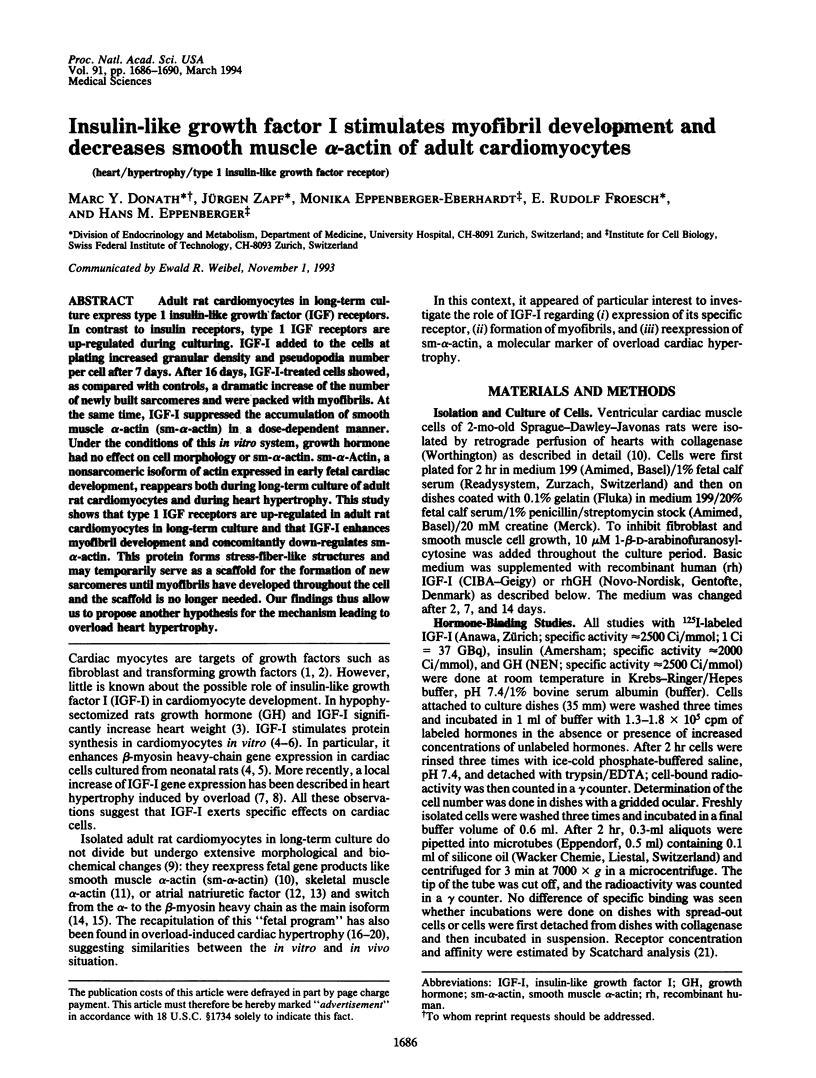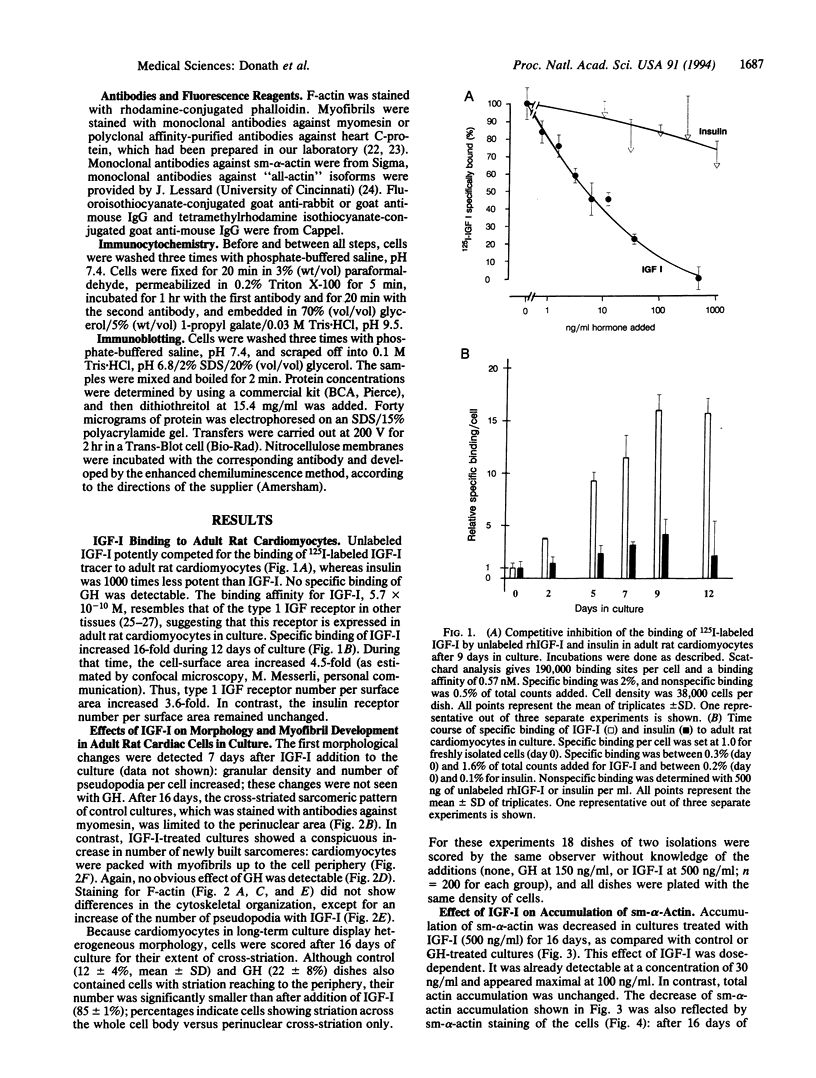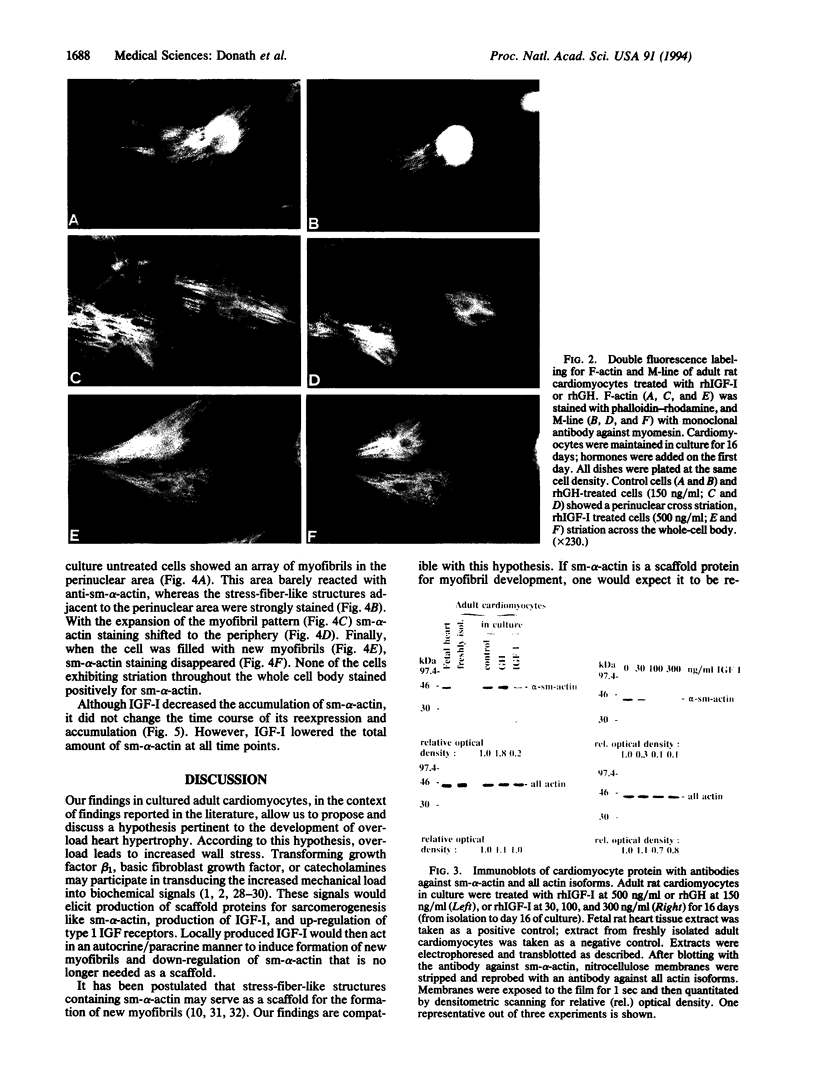Abstract
Adult rat cardiomyocytes in long-term culture express type 1 insulin-like growth factor (IGF) receptors. In contrast to insulin receptors, type 1 IGF receptors are up-regulated during culturing. IGF-I added to the cells at plating increased granular density and pseudopodia number per cell after 7 days. After 16 days, IGF-I-treated cells showed, as compared with controls, a dramatic increase of the number of newly built sarcomeres and were packed with myofibrils. At the same time, IGF-I suppressed the accumulation of smooth muscle alpha-actin (sm-alpha-actin) in a dose-dependent manner. Under the conditions of this in vitro system, growth hormone had no effect on cell morphology or sm-alpha-actin. sm-alpha-Actin, a nonsarcomeric isoform of actin expressed in early fetal cardiac development, reappears both during long-term culture of adult rat cardiomyocytes and during heart hypertrophy. This study shows that type 1 IGF receptors are up-regulated in adult rat cardiomyocytes in long-term culture and that IGF-I enhances myofibril development and concomitantly down-regulates sm-alpha-actin. This protein forms stress-fiber-like structures and may temporarily serve as a scaffold for the formation of new sarcomeres until myofibrils have developed throughout the cell and the scaffold is no longer needed. Our findings thus allow us to propose another hypothesis for the mechanism leading to overload heart hypertrophy.
Full text
PDF




Images in this article
Selected References
These references are in PubMed. This may not be the complete list of references from this article.
- Black F. M., Packer S. E., Parker T. G., Michael L. H., Roberts R., Schwartz R. J., Schneider M. D. The vascular smooth muscle alpha-actin gene is reactivated during cardiac hypertrophy provoked by load. J Clin Invest. 1991 Nov;88(5):1581–1588. doi: 10.1172/JCI115470. [DOI] [PMC free article] [PubMed] [Google Scholar]
- Bähler M., Moser H., Eppenberger H. M., Wallimann T. Heart C-protein is transiently expressed during skeletal muscle development in the embryo, but persists in cultured myogenic cells. Dev Biol. 1985 Dec;112(2):345–352. doi: 10.1016/0012-1606(85)90405-1. [DOI] [PubMed] [Google Scholar]
- Chien K. R., Knowlton K. U., Zhu H., Chien S. Regulation of cardiac gene expression during myocardial growth and hypertrophy: molecular studies of an adaptive physiologic response. FASEB J. 1991 Dec;5(15):3037–3046. doi: 10.1096/fasebj.5.15.1835945. [DOI] [PubMed] [Google Scholar]
- Claycomb W. C. Atrial-natriuretic-factor mRNA is developmentally regulated in heart ventricles and actively expressed in cultured ventricular cardiac muscle cells of rat and human. Biochem J. 1988 Oct 15;255(2):617–620. [PMC free article] [PubMed] [Google Scholar]
- Dlugosz A. A., Antin P. B., Nachmias V. T., Holtzer H. The relationship between stress fiber-like structures and nascent myofibrils in cultured cardiac myocytes. J Cell Biol. 1984 Dec;99(6):2268–2278. doi: 10.1083/jcb.99.6.2268. [DOI] [PMC free article] [PubMed] [Google Scholar]
- Eid H., Larson D. M., Springhorn J. P., Attawia M. A., Nayak R. C., Smith T. W., Kelly R. A. Role of epicardial mesothelial cells in the modification of phenotype and function of adult rat ventricular myocytes in primary coculture. Circ Res. 1992 Jul;71(1):40–50. doi: 10.1161/01.res.71.1.40. [DOI] [PubMed] [Google Scholar]
- Engelmann G. L., Boehm K. D., Haskell J. F., Khairallah P. A., Ilan J. Insulin-like growth factors and neonatal cardiomyocyte development: ventricular gene expression and membrane receptor variations in normotensive and hypertensive rats. Mol Cell Endocrinol. 1989 May;63(1-2):1–14. doi: 10.1016/0303-7207(89)90076-2. [DOI] [PubMed] [Google Scholar]
- Eppenberger-Eberhardt M., Flamme I., Kurer V., Eppenberger H. M. Reexpression of alpha-smooth muscle actin isoform in cultured adult rat cardiomyocytes. Dev Biol. 1990 Jun;139(2):269–278. doi: 10.1016/0012-1606(90)90296-u. [DOI] [PubMed] [Google Scholar]
- Eppenberger-Eberhardt M., Messerli M., Eppenberger H. M., Reinecke M. New occurrence of atrial natriuretic factor and storage in secretorially active granules in adult rat ventricular cardiomyocytes in long-term culture. J Mol Cell Cardiol. 1993 Jul;25(7):753–757. doi: 10.1006/jmcc.1993.1088. [DOI] [PubMed] [Google Scholar]
- Eppenberger M. E., Hauser I., Baechi T., Schaub M. C., Brunner U. T., Dechesne C. A., Eppenberger H. M. Immunocytochemical analysis of the regeneration of myofibrils in long-term cultures of adult cardiomyocytes of the rat. Dev Biol. 1988 Nov;130(1):1–15. doi: 10.1016/0012-1606(88)90408-3. [DOI] [PubMed] [Google Scholar]
- Florini J. R., Ewton D. Z. Induction of gene expression in muscle by the IGFs. Growth Regul. 1992 Mar;2(1):23–29. [PubMed] [Google Scholar]
- Fuller S. J., Mynett J. R., Sugden P. H. Stimulation of cardiac protein synthesis by insulin-like growth factors. Biochem J. 1992 Feb 15;282(Pt 1):85–90. doi: 10.1042/bj2820085. [DOI] [PMC free article] [PubMed] [Google Scholar]
- Grove B. K., Kurer V., Lehner C., Doetschman T. C., Perriard J. C., Eppenberger H. M. A new 185,000-dalton skeletal muscle protein detected by monoclonal antibodies. J Cell Biol. 1984 Feb;98(2):518–524. doi: 10.1083/jcb.98.2.518. [DOI] [PMC free article] [PubMed] [Google Scholar]
- Guler H. P., Zapf J., Scheiwiller E., Froesch E. R. Recombinant human insulin-like growth factor I stimulates growth and has distinct effects on organ size in hypophysectomized rats. Proc Natl Acad Sci U S A. 1988 Jul;85(13):4889–4893. doi: 10.1073/pnas.85.13.4889. [DOI] [PMC free article] [PubMed] [Google Scholar]
- Humbel R. E. Insulin-like growth factors I and II. Eur J Biochem. 1990 Jul 5;190(3):445–462. doi: 10.1111/j.1432-1033.1990.tb15595.x. [DOI] [PubMed] [Google Scholar]
- Izumo S., Lompré A. M., Matsuoka R., Koren G., Schwartz K., Nadal-Ginard B., Mahdavi V. Myosin heavy chain messenger RNA and protein isoform transitions during cardiac hypertrophy. Interaction between hemodynamic and thyroid hormone-induced signals. J Clin Invest. 1987 Mar;79(3):970–977. doi: 10.1172/JCI112908. [DOI] [PMC free article] [PubMed] [Google Scholar]
- Izumo S., Nadal-Ginard B., Mahdavi V. Protooncogene induction and reprogramming of cardiac gene expression produced by pressure overload. Proc Natl Acad Sci U S A. 1988 Jan;85(2):339–343. doi: 10.1073/pnas.85.2.339. [DOI] [PMC free article] [PubMed] [Google Scholar]
- Lattion A. L., Michel J. B., Arnauld E., Corvol P., Soubrier F. Myocardial recruitment during ANF mRNA increase with volume overload in the rat. Am J Physiol. 1986 Nov;251(5 Pt 2):H890–H896. doi: 10.1152/ajpheart.1986.251.5.H890. [DOI] [PubMed] [Google Scholar]
- Lessard J. L. Two monoclonal antibodies to actin: one muscle selective and one generally reactive. Cell Motil Cytoskeleton. 1988;10(3):349–362. doi: 10.1002/cm.970100302. [DOI] [PubMed] [Google Scholar]
- Morgan H. E., Gordon E. E., Kira Y., Chua H. L., Russo L. A., Peterson C. J., McDermott P. J., Watson P. A. Biochemical mechanisms of cardiac hypertrophy. Annu Rev Physiol. 1987;49:533–543. doi: 10.1146/annurev.ph.49.030187.002533. [DOI] [PubMed] [Google Scholar]
- Nag A. C., Cheng M. Biochemical evidence for cellular dedifferentiation in adult rat cardiac muscle cells in culture: expression of myosin isozymes. Biochem Biophys Res Commun. 1986 Jun 13;137(2):855–862. doi: 10.1016/0006-291x(86)91158-7. [DOI] [PubMed] [Google Scholar]
- Parker T. G., Chow K. L., Schwartz R. J., Schneider M. D. Differential regulation of skeletal alpha-actin transcription in cardiac muscle by two fibroblast growth factors. Proc Natl Acad Sci U S A. 1990 Sep;87(18):7066–7070. doi: 10.1073/pnas.87.18.7066. [DOI] [PMC free article] [PubMed] [Google Scholar]
- Parker T. G., Packer S. E., Schneider M. D. Peptide growth factors can provoke "fetal" contractile protein gene expression in rat cardiac myocytes. J Clin Invest. 1990 Feb;85(2):507–514. doi: 10.1172/JCI114466. [DOI] [PMC free article] [PubMed] [Google Scholar]
- Rosenthal S. M., Brunetti A., Brown E. J., Mamula P. W., Goldfine I. D. Regulation of insulin-like growth factor (IGF) I receptor expression during muscle cell differentiation. Potential autocrine role of IGF-II. J Clin Invest. 1991 Apr;87(4):1212–1219. doi: 10.1172/JCI115121. [DOI] [PMC free article] [PubMed] [Google Scholar]
- Russell-Jones D. L., Leach R. M., Ward J. P., Thomas C. R. Insulin-like growth factor-I gene expression is increased in the right ventricular hypertrophy induced by chronic hypoxia in the rat. J Mol Endocrinol. 1993 Feb;10(1):99–102. doi: 10.1677/jme.0.0100099. [DOI] [PubMed] [Google Scholar]
- Sanger J. W., Mittal B., Sanger J. M. Analysis of myofibrillar structure and assembly using fluorescently labeled contractile proteins. J Cell Biol. 1984 Mar;98(3):825–833. doi: 10.1083/jcb.98.3.825. [DOI] [PMC free article] [PubMed] [Google Scholar]
- Schneider M. D., Parker T. G. Cardiac myocytes as targets for the action of peptide growth factors. Circulation. 1990 May;81(5):1443–1456. doi: 10.1161/01.cir.81.5.1443. [DOI] [PubMed] [Google Scholar]
- Schwartz K., de la Bastie D., Bouveret P., Oliviéro P., Alonso S., Buckingham M. Alpha-skeletal muscle actin mRNA's accumulate in hypertrophied adult rat hearts. Circ Res. 1986 Nov;59(5):551–555. doi: 10.1161/01.res.59.5.551. [DOI] [PubMed] [Google Scholar]
- Schwarzfeld T. A., Jacobson S. L. Isolation and development in cell culture of myocardial cells of the adult rat. J Mol Cell Cardiol. 1981 Jun;13(6):563–575. doi: 10.1016/0022-2828(81)90327-8. [DOI] [PubMed] [Google Scholar]
- Wåhlander H., Isgaard J., Jennische E., Friberg P. Left ventricular insulin-like growth factor I increases in early renal hypertension. Hypertension. 1992 Jan;19(1):25–32. doi: 10.1161/01.hyp.19.1.25. [DOI] [PubMed] [Google Scholar]
- Zapf J., Mäder M., Waldvogel M., Schalch D. S., Froesch E. R. Specific binding of nonsupressible insulinlike activity to chicken embryo fibroblasts and to a solubilized fibroblast receptor. Arch Biochem Biophys. 1975 Jun;168(2):630–637. doi: 10.1016/0003-9861(75)90295-7. [DOI] [PubMed] [Google Scholar]






